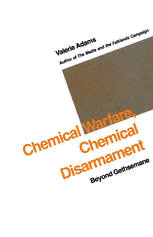Table Of ContentCHEMICAL WARFARE, CHEMICAL
DISARMAMENT: BEYOND GETHSEMANE
Also by Valerie Adams
TilE FALKLANDS CONFLICT
*TilE MEDIA AND TilE FALKLANDS CAMPAIGN
• Also published by Palg rave Macmillan
Chemical Warfare,
Chemical Disarmament:
Beyond Gethsemane
Valerie Adams
M
MACMILLAN
© Valerie Adams 1989
Softcover reprint of the hardcover 1st edition 1989
All rights reserved. No reproduction, copy or transmission
of this publication may be made without written permission.
No paragraph of this publication may be reproduced, copied
or transmitted save with written permission or in accordance
with the provisions of the Copyright Act 1956 (as amended),
or under the terms of any licence permitting limited copying
issued by the Copyright Licensing Agency, 33-34 Alfred Place,
London WC1E 7DP.
Any person who does any unauthorised act in relation to
this publication may be liable to criminal prosecution and
civil claims for damages.
First published 1989
Published by
THE MACMILLAN PRESS LTD
Houndmills, Basingstoke, Hampshire RG21 2XS
and London
Companies and representatives
throughout the world
British Library Cataloguing in Publication Data
Adams, Valerie, 1950--
Chemical warfare, chemical disarmament:
Beyond Gethsemane.
1. Chemical Warfare, to 1988
I. Title
355'.0217
ISBN 978-1-349-08905-5 ISBN 978-1-349-08903-1 (eBook)
DOI 10.1007/978-1-349-08903-1
The garden called Gethsemane
In Picardy it was,
And there the people came to see
The English soldiers pass.
We used to pass - we used to pass
Or halt, as it might be,
And ship our masks in case of gas
Beyond Gethsemane
'Gethsemane 1914-18',
Rudyard Kipling
Contents
List of Tables ix
Introduction xi
1 'Trouble in the Wind' 1
2 'The Air a River of Opaque Filth' 25
3 'A Matter of Fashion Changing' 45
4 'A Green Country ... Knocked Silly by Guns' 71
5 'Still Falls the Rain' 91
6 'Quantity has a Quality of Its Own' 119
7 'An Armed and Agile Nation' 144
8 'And the Living Nations Wait' 167
9 'Will It Be So Again?' 198
Notes 223
Bibliography 256
Index 269
List of Tables
1.1 Main CW Agents 10
7.1 CW Programme Funding FY 81-83 in $m 154
Introduction
This study arose out of my own sense of frustration as an official in
the Ministry of Defence, working on chemical disarmament.
Whether or not one agrees with it, the rationale for the possession of
nuclear weapons is relatively straightforward; the issues raised by
chemical warfare seemed more complex, often contradictory. The
ground on which policy was being made shifted, depending on the
imperative of the moment.
That was nearly ten years ago, but nothing which has happened in
the meantime has made the issues any less complex, or the subject of
less importance. Chemical weapons are not at the forefront of
defence policy-making; compared to nuclear or conventional
weapons, they have a limited place in the strategy of deterrence.
Nonetheless, developments over the past decade -growing concerns
in NATO about the Soviet threat, allegations of use in Asia and the
Middle East, progress towards banning them, and the modernisation
of the US chemical arsenal-have all kept them in the public eye. The
issues, and their resolution, have become more pressing.
I am acutely conscious of the shortcomings of this study: compress
ing the enormous amount of material available into a single volume
has inevitably meant omitting interesting and relevant material-such
as discussion of the US programme for chemical weapon destruction.
Although I have not set a formal cut-off date, events after early 1988
are necessarily dealt with somewhat cursorily. I have tried to include
historical and contemporary material which throws light on what
seem to me to be the two main questions - how did we get into our
current position, and where should we go from here? I do not claim
to have any perfect answers: the most one can do is indicate that a
certain direction is probably the best way forward.
This book could not have been produced without the financial
assistance of the Joseph Rowntree Charitable Trust, and I am most
grateful to the trustees. Like all academics working in this field, I
must acknowledge my debt to the numerous SIPRI publications on
this subject, and to the author of many of them, Julian Perry
Robinson, whose help has been generous and invaluable. I should
like also to offer particular thanks for their encouragement and
practical assistance to Lawrence Freedman and Dr John Walker, and
xi
xii Introduction
to Dr Graham Pearson for permitting me to visit the Chemical
Defence Establishment (CDE) at Parton Down. Many others have
kindly shared their time and knowledge, among them Ian Andrews,
Alan Bebbington, Brian Bond, John Bullock, Graden Carter, Marie
Colvin, Charles Dick, Chris Donnelly, Elisa Harris, John Hemsley,
Dr B. Jasani, Efraim Karsh, Margot Kirk, Jim Steinberg, David
Summerhayes, Sandy Verschbow; the staffs of the libraries at the
United Nations office in London, at the Royal United Services
Institute, the US Embassy, and the British Newspaper Library at
Colindale. I acknowledge also the assistance of the Liddell Hart
Centre for Military Archives at King's College, London, and am
grateful for their permission to quote from the Foulkes and Liddell
Hart papers held there.
My greatest debts are to my parents, Jim and Eileen Bell, for their
unfailing enthusiasm and encouragement, and especially to my
husband, Derek Adams, who read both text and proofs, offered
constant support-and cooked the supper, night after night!
For those interested in such things, the quotations in the chapter
headings are taken from Rudyard Kipling (Tommy Atkins,
Danegeld), Herbert Read (Beata l'Alma), Winston S. Churchill,
Edmund Blunden (Report on Experience), Dame Edith Sitwell (Still
Falls the Rain: The Raids 1940, Night and Dawn), I.V. Lenin
(attrib.), W.H. Auden (In Memory ofW.B. Yeats), Cecil Day Lewis
(Will it be so again?).
Finally, I must make clear that the opinions expressed in this book
are my own and do not reflect the official views of the Ministry of
Defence.

